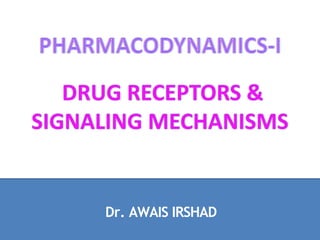
Pharmacodynamics.pptx
- 2. By the end of this lecture Student should be able to : Define the drug receptor, types, location and mechanism of receptor regulation. Enlist the transmembrane signaling methods by which drug receptor interactions exert their effects. ilos
- 3. Pharmacodynamics is a branch of pharmacology that deals with the study of the biochemical and physiological effects of drugs and their mechanisms of action. What is Pharmacodynamics
- 5. ARECEPTOR structure Coupler Transducti on o Ligand recognition site o Inner catalyticdomain
- 6. Type I (Ion Channel-Linked receptors) Type II (G-Protein coupled receptors) Type III (Enzyme-Linked receptors) Type IV (Receptors linked to gene transcription)
- 7. Type I Type II Type III Type IV Location Membrane Membrane Membrane Nucleus Coupling Direct G-Protein Direct Via DNA Synaptic transmission Very Fast fast slow Very slow Response milliseconds Seconds minutes Hours or days Examples Nicotinic receptors Muscarinic receptors Adrenerg ic receptors Insulin receptors Estrogen Steroid receptors Effectors channels Channels/ enzymes Enzymes DNA
- 8. TYPE I : Ion Channel-Linked receptors Ligand gated ion channels Ionotropic receptors o Located at cell membrane o Directly activated by ligand binding o Directly related to ion channels. o Involved in very fast synaptic transmission. o Response occurs in milliseconds.
- 9. Channel-Linked Receptor 1 Ionotropic Receptor Ligand- Gated-Ion Channel e.g. nicotinic receptors that are activated by occupancy of a ligand as acetylcholine.
- 10. Type II: G-Protein coupled receptors Metabotropic Receptor o The largest family that accounts for many known drug targets o Located at cell membrane o Coupled to intracellular effectors via G- protein o Response through ion channels or enzymes. o Involved in rapid transduction o Response occurs in seconds. o E.g. Muscarinic receptors of Ach
- 11. Type III (Enzyme-Linked receptors) (Tyrosine Kinase-linked receptor) o Located at cell membrane o Linked to enzyme (with intrinsic enzymatic activity) o Response occurs in minutes to hours. o Involved in response to hormones, growth factors. o They control many cellular functions as metabolism and growth.
- 12. Type III (Enzyme-Linked receptors) (Tyrosine Kinase-linked receptor) o Activation of Type III receptors results in o Activation of kinases as tyrosine kinase with phosphorylation of tyrosine residue on their substrates and activation of many intracellular signaling pathways in the cell. E.g. Insulin receptors
- 13. Type IV: Nuclear receptors Gene transcription receptors o Located intracellularly o Directly related to DNA (Gene transcription). o Activation of receptors either increase or decrease protein synthesis o Response occurs in hours or days and persists longer. o Their natural ligands are lipophylic hormones; steroids, thyroids, estrogen.
- 14. What a r e the mechanisms o f drug action
- 15. How drugs produce action? What are targets for drug binding ? Receptor-mediated mechanisms Non receptor-mediated mechanisms Drugs Drug actions
- 16. Drugs can produce their actions by one of the following mechanisms: 1) Receptor-mediated mechanisms (Binding with biomolecules): • Receptors =Biomolecules = Targets • Targets are mostly protein in nature. 1) Non receptor-mediated mechanisms Physiochemical properties of drugs. What a r e the mechanisms o f drug action
- 17. Non receptor–mediated mechanisms Drugs can produce actions by: Chemical action – Neutralization of gastric acidity by antacids. Physical action – Osmotic diuretics. – Purgatives used in treatment of constipation e.g. MgSO4
- 18. Drugs can produce actions by binding with biomolecules (Protein Targets) Protein targets for drug binding o Structural protein o Regulatory proteins Physiological receptors Enzymes Ion channels Carriers Receptor–mediated mechanisms
- 20. Recepto rs Is a special target macromolecule that binds the drug and mediates its pharmacological actions. Where are receptors located? • Cell membrane. • Cytoplasm. • Nucleus.
- 21. Enzymes • The drug competes with the natural endogenous substrate for the enzyme. • E.g. Anticholinesterases inhibit acetylcholinesterase thus producing cholinomimetic action. • Neostigmine reversibly compete with ACH for acetyl cholinesterase enzyme at motor end plate (neuromuscular junction). • Organophosphates irreversibly competes with ACH for acetyl cholinesterase enzyme.
- 22. Ion channels • Drugs bind to alter channel function (by opening or blockade). • Channels are responsible for influx or outflux of ions through cell membranes. • They are activated by alteration in action potential.
- 23. Ion channels e.g. local anesthetics: act by blocking sodium (Na+) influx through Na channel in nerve fibers (Na channel blockers).
- 24. >Proteins TARGETS REGULATO RY ION CHANN EL Local Anesthetics block Na influx through Na channel in nerve fibers. They are Na channel Blockers. L.Anaesthes ia
- 25. Ion channels • e.g. Sulfonylurea drugs (antidiabetic drugs): block potassium channels in pancreatic beta cells resulting in depolarization and opening of calcium channels and insulin secretion.
- 27. Carrier molecules o Drugs bind to such molecules to alter their transport ability. o Responsible for transport of ions and small organic molecules between intracellular compartments, through cell membranes or in extracellular fluids. o e.g. Na pump (Na+/K+ ATPase) blocked by digoxin. o e.g. dopamine transporter blocked by cocaine.
- 28. Carrier molecules Digoxin: blocks Na efflux via Na+/K+ pump or sodium- potassium pump (Na+/K+- ATPase ); used in the treatment of heart failure. Cocaine: o blocks transport or reuptake of (catecholamines mainly dopamine) at synaptic cleft. o The dopamine transporter can no longer perform its reuptake function, and thus
- 29. What are the binding Forces between drugs and receptors? – Ionic bond. – Van-Dar-Waal. – Hydrogen bond. – Covalent bond.
- 30. Affinity Ability of a drug to combine with the receptor. D + R D-R complex Effect. Efficacy (Intrinsic Activity) –Capacity of a drug receptor complex (D-R) to produce an action. –is the maximal response produced by a drug (E max).
- 32. What is Agonist? What is full Agonist? What is PartialAgonist? What isAntagonist? What are the types ofAntagonist?
- 33. References: 1. B G Katzung. Basic and clinical pharmacology, 14th edition pp20-40 2. Lippincott illustrated reviews pharmacology, 7th edition pp23-36 3. Katzung and Trevor's pharmacology examination and board review pp 16-25
- 34. Thank you Adapt it with your needs and it will capture all the audience attention.
